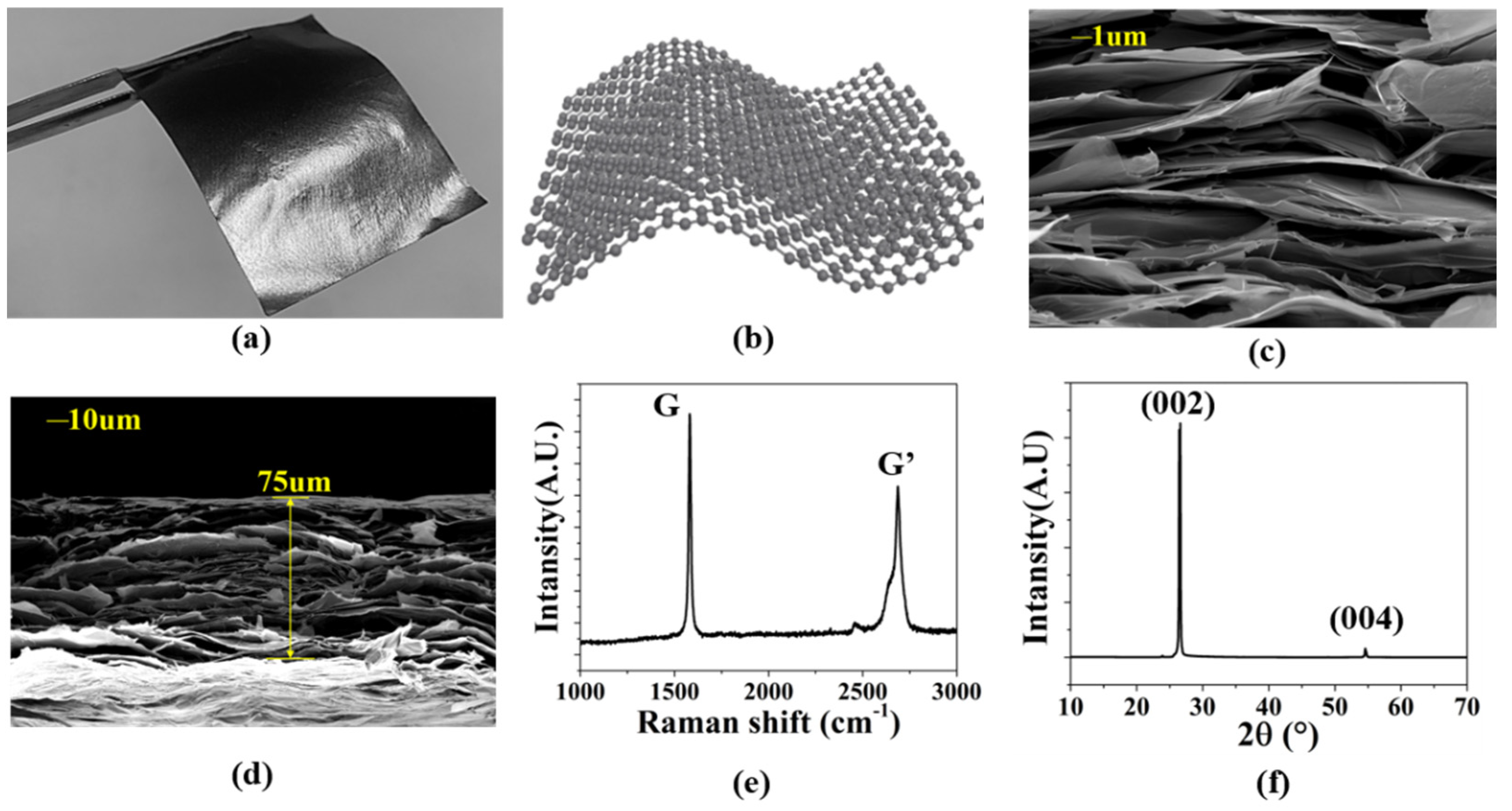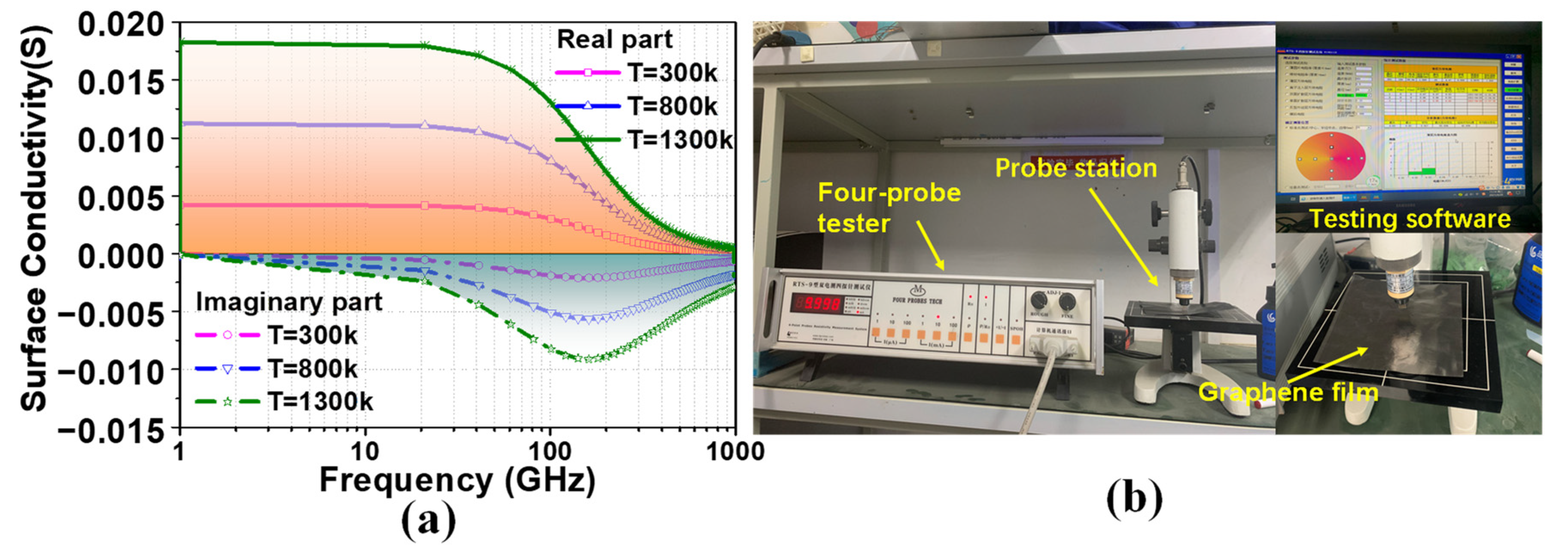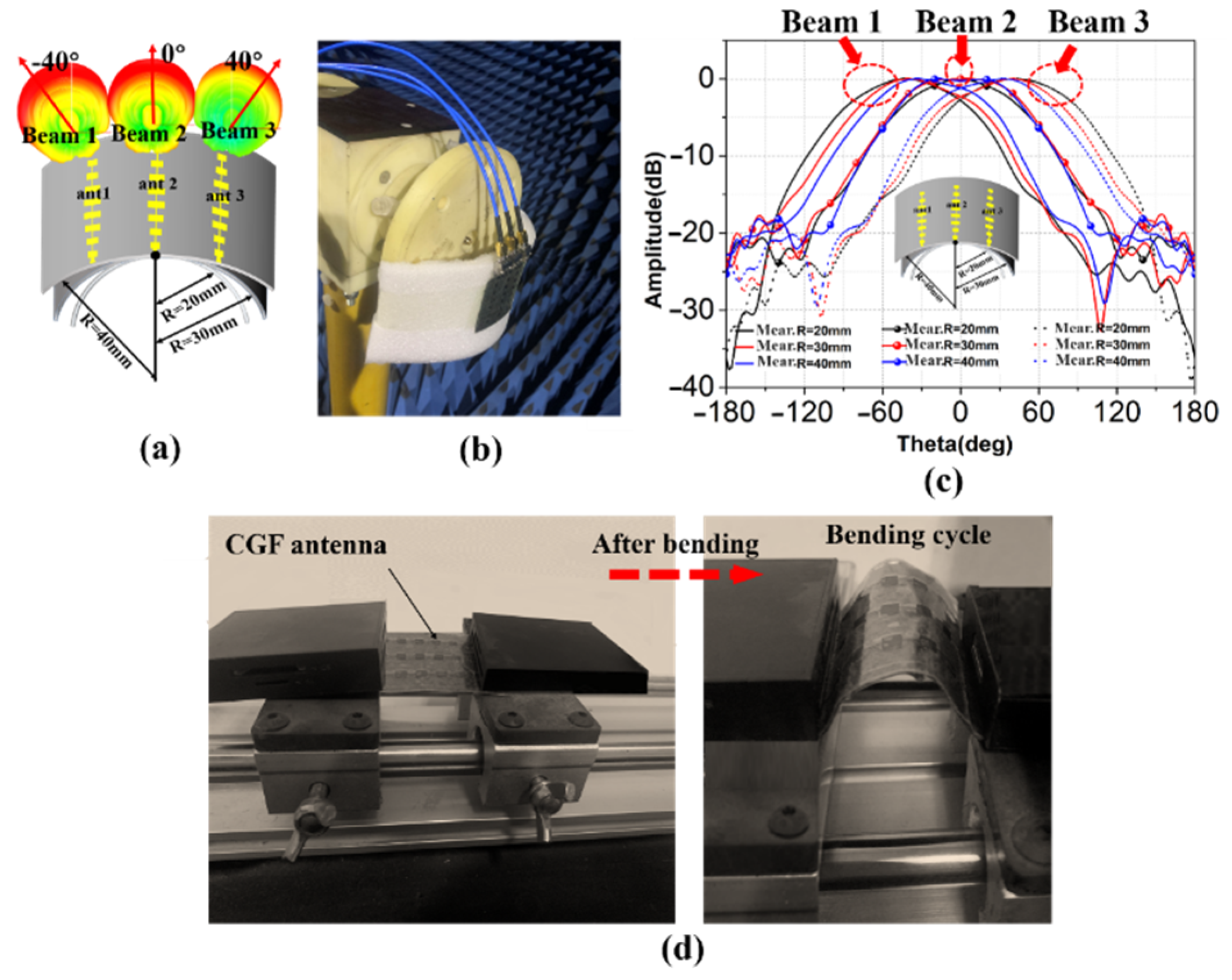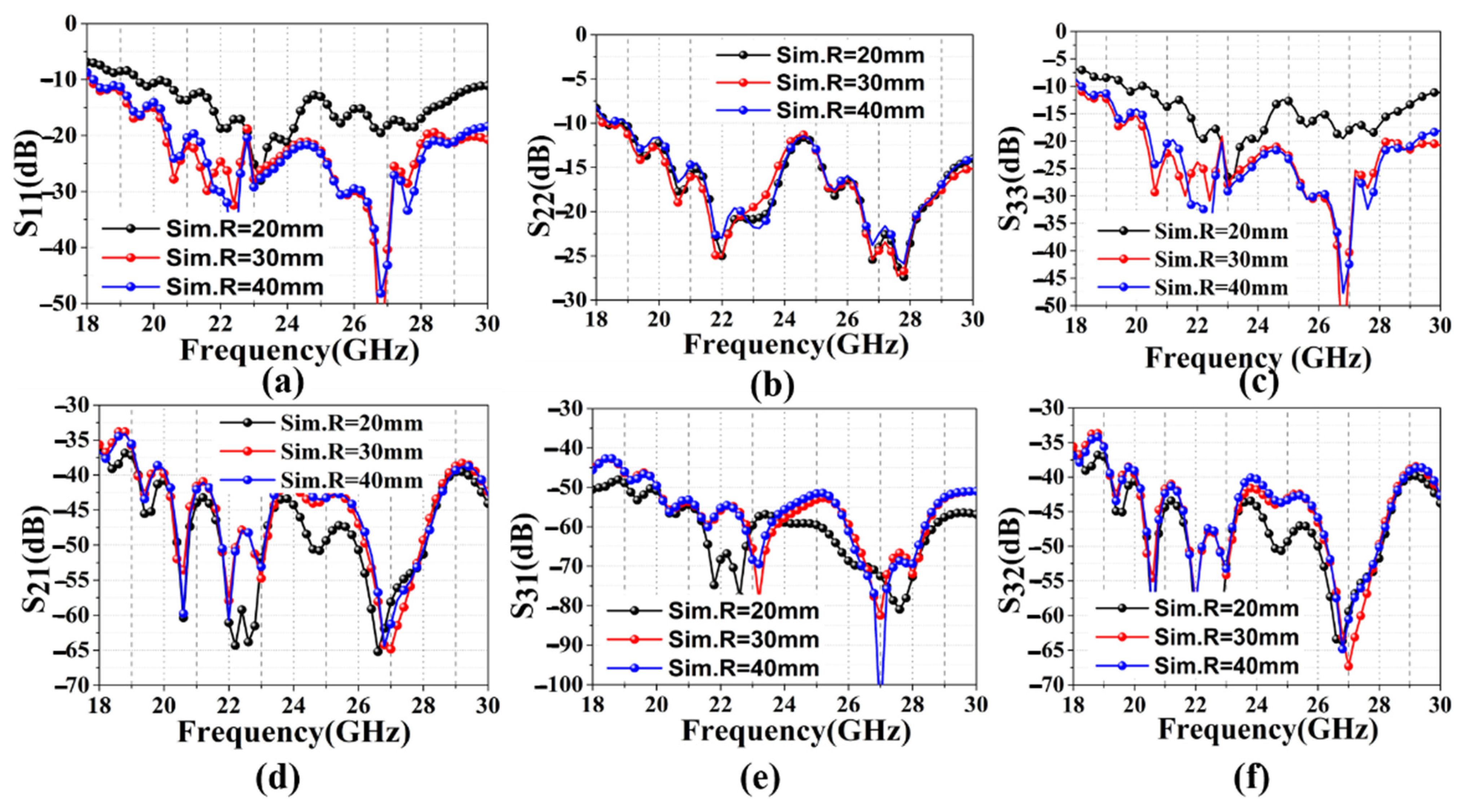Multi-Beam Conformal Array Antenna Based on Highly Conductive Graphene Films for 5G Micro Base Station Applications
Abstract
1. Introduction
2. Materials and Methods
2.1. Characterization of the CGF
2.2. Chebyshev Linear Series-Fed Antenna Array
3. Results
- Firstly, we fabricated a graphene antenna prototype.
- Then, to illustrate the influence of the conformal radius on the mutual coupling of the three linear arrays, we tested the S-parameter and the far field radiation patterns of the CGF antenna, as shown in Figure 5 and Figure 6. The antenna was conformed on foam cylinders with radii of 20 mm, 30 mm, and 40 mm, respectively.
- Finally, a 30 mm conformal cylinder was used to compare the measured and simulated reflection coefficients and the realized gains, as shown in Figure 7.
3.1. The Fabrication of the Conformal CGF Antenna
3.2. Measured Results
3.2.1. Conformal Experiment
3.2.2. Comparison of the Simulation and Measurement
4. Discussion
5. Conclusions
Author Contributions
Funding
Institutional Review Board Statement
Informed Consent Statement
Data Availability Statement
Acknowledgments
Conflicts of Interest
References
- Mao, C.-X.; Khalily, M.; Xiao, P.; Brown, T.W.C.; Gao, S. Planar Sub-Millimeter-Wave Array Antenna with Enhanced Gain and Reduced Sidelobes for 5G Broadcast Applications. IEEE Trans. Antennas Propag. 2019, 67, 160–168. [Google Scholar] [CrossRef]
- Jilani, S.F.; Munoz, M.O.; Abbasi, Q.H.; Alomainy, A. Millimeter-Wave Liquid Crystal Polymer Based Conformal Antenna Array for 5G Applications. IEEE Antennas Wirel. Propag. Lett. 2018, 18, 84–88. [Google Scholar] [CrossRef]
- Ding, Y.; Duan, H.; Xie, M.; Mao, R.; Wang, J.; Zhang, W. Carbon emissions and mitigation potentials of 5G base station in China. Resour. Conserv. Recycl. 2022, 182, 0921–3449. [Google Scholar] [CrossRef]
- Scidà, A.; Haque, S.; Treossi, E.; Robinson, A.; Smerzi, S.; Ravesi, S.; Borini, S.; Palermo, V. Application of graphene-based flexible antennas in consumer electronic devices. Mater. Today 2018, 21, 223–230. [Google Scholar] [CrossRef]
- Hong, W.; Jiang, Z.H.; Yu, C.; Zhou, J.; Chen, P.; Yu, Z.; Zhang, H.; Yang, B.; Pang, X.; Jiang, M.; et al. Multibeam Antenna Technologies for 5G Wireless Communications. IEEE Trans. Antennas Propag. 2017, 65, 6231–6249. [Google Scholar] [CrossRef]
- Marcus, M.J. 5G and “IMT for 2020 and beyond”. IEEE Wirel. Commun. 2015, 22, 2–3. [Google Scholar] [CrossRef]
- Hong, W. Solving the 5G Mobile Antenna Puzzle: Assessing Future Directions for the 5G Mobile Antenna Paradigm Shift. IEEE Microw. Mag. 2017, 18, 86–102. [Google Scholar] [CrossRef]
- Jia, Q.; Xu, H.; Xiong, M.F.; Zhang, B.; Duan, J. Omnidirectional Solid Angle Beam-Switching Flexible Array Antenna in Millimeter Wave for 5G Micro Base Station Applications. IEEE Access 2019, 7, 157027–157036. [Google Scholar] [CrossRef]
- Wen, S.; Dong, Y. A Low-Profile Wideband Antenna With Monopolelike Radiation Characteristics for 4G/5G Indoor Micro Base Station Application. IEEE Antennas Wirel. Propag. Lett. 2020, 19, 2305–2309. [Google Scholar] [CrossRef]
- Duan, Z.; Wang, J.; Xu, L.; Wang, F.; Geyi, W. Pattern and polarization reconfigurable loop antenna with circular high-impedance surface for 5G micro base station application. Int. J. RF Microw. Comput. Eng. 2022, 32, e23359. [Google Scholar] [CrossRef]
- Anwar, M.S.; Bangert, A. 3D printed microfluidics-based reconfigurable antenna. In Proceedings of the 2017 IEEE MTT-S International Microwave Workshop Series on Advanced Materials and Processes for RF and THz Applications, Pavia, Italy, 20–22 September 2017. [Google Scholar]
- Elibiary, A.; Jun, S.Y.; Chen, Z.; Bird, D. 3D Printed Fingernail Antennas for 5G Applications. IEEE Access 2020, 8, 228711–228719. [Google Scholar]
- Grouchko, M.; Kamyshny, A.; Magdassi, S. Formation of air-stable copper–silver core–shell nanoparticles for inkjet printing. J Mater Chem. 2009, 19, 3057–3062. [Google Scholar] [CrossRef]
- Leng, T.; Huang, X.; Chang, K.; Chen, J.; Abdalla, M.A.; Hu, Z. Graphene Nanoflakes Printed Flexible Meandered-Line Dipole Antenna on Paper Substrate for Low-Cost RFID and Sensing Applications. IEEE Antennas Wirel. Propag. Lett. 2016, 15, 1565–1568. [Google Scholar] [CrossRef]
- Song, R.; Huang, G.-L.; Liu, C.; Zhang, N.; Zhang, J.; Liu, C.; Wu, Z.P.; He, D. High-conductive graphene film based antenna array for 5G mobile communications. Int. J. RF Microw. Comput. Eng. 2019, 29, e21692. [Google Scholar] [CrossRef]
- Chen, X.; Liu, X.; Li, S.; Wang, W.; Wei, D.; Wu, Y.; Liu, Z. Tunable wideband slot antennas based on printable graphene inks. Nanoscale 2020, 12, 10949–10955. [Google Scholar] [CrossRef] [PubMed]
- Akbari, M.; Khan, M.W.A.; Hasani, M.; Bjorninen, T.; Sydanheimo, L.; Ukkonen, L. Fabrication and Characterization of Graphene Antenna for Low-Cost and Environmentally Friendly RFID Tags. IEEE Antennas Wirel. Propag. Lett. 2016, 15, 1569–1572. [Google Scholar] [CrossRef]
- Geim, A.K.; Novoselov, K.S. The rise of graphene. Nature 2010, 6, 183–191. [Google Scholar] [CrossRef]
- Novoselov, K.S.; Jiang, Z.; Zhang, Y.; Morozov, S.V.; Stormer, H.L.; Zeitler, U.; Maan, J.C.; Boebinger, G.S.; Kim, P.; Geim, A.K. Room-Temperature Quantum Hall Effect in Graphene. Science 2007, 315, 1379. [Google Scholar] [CrossRef]
- Fang, R.; Song, R.; Zhao, X.; Wang, Z.; Qian, W.; He, D. Compact and Low-Profile UWB Antenna Based on Graphene-Assembled Films for Wearable Applications. Sensors 2020, 20, 2552. [Google Scholar] [CrossRef]
- Zhang, J.; Song, R.; Zhao, X.; Fang, R.; Zhang, B.; Qian, W.; Zhang, J.; Liu, C.; He, D. Flexible Graphene-Assembled Film-Based Antenna for Wireless Wearable Sensor with Miniaturized Size and High Sensitivity. ACS Omega 2020, 5, 12937–12943. [Google Scholar] [CrossRef]
- Zu, H.-R.; Wu, B.; Zhang, Y.-H.; Zhao, Y.-T.; Song, R.-G.; He, D.-P. Circularly Polarized Wearable Antenna with Low Profile and Low Specific Absorption Rate Using Highly Conductive Graphene Film. IEEE Antennas Wirel. Propag. Lett. 2020, 19, 2354–2358. [Google Scholar] [CrossRef]
- Song, R.; Wang, Z.; Zu, H.; Chen, Q.; Mao, B.; Wu, Z.P.; He, D. Wideband and low sidelobe graphene antenna array for 5G applications. Sci. Bull. 2020, 66, 103–106. [Google Scholar] [CrossRef]
- Fan, C.; Wu, B.; Song, R.; Zhao, Y.; Zhang, Y.; He, D. Electromagnetic shielding and multi-beam radiation with high conductivity multilayer graphene film. Carbon 2019, 155, 506–513. [Google Scholar] [CrossRef]
- Jiang, S.; Song, R.; Hu, Z.; Xin, Y.; Huang, G.-L.; He, D. Millimeter wave phased array antenna based on highly conductive graphene-assembled film for 5G applications. Carbon 2022, 196, 493–498. [Google Scholar] [CrossRef]
- Semkin, V.; Bisognin, A.; Kyrö, M.; Kolmonen, V.-M.; Luxey, C.; Ferrero, F.; Devillers, F.; Räisänen, A. Conformal antenna array for millimeter-wave communications: Performance evaluation. Int. J. Microw. Wirel. Technol. 2015, 9, 241–247. [Google Scholar] [CrossRef]
- Khan, A.K.; Shaem, T.A.; Alim, M.A. Graphene patch antennas with different substrate shapes and materials. Optik 2020, 202, 163700. [Google Scholar] [CrossRef]
- Chang, Z.; You, B.; Wu, L.-S.; Tang, M.; Zhang, Y.-P.; Mao, J.-F. A Reconfigurable Graphene Reflectarray for Generation of Vortex THz Waves. IEEE Antennas Wirel. Propag. Lett. 2016, 15, 1537–1540. [Google Scholar] [CrossRef]
- Fang, X.-Y.; Yu, X.-X.; Zheng, H.-M.; Jin, H.-B.; Wang, L.; Cao, M.-S. Temperature- and thickness-dependent electrical conductivity of few-layer graphene and graphene nanosheets. Phys. Lett. A 2015, 379, 2245–2251. [Google Scholar] [CrossRef]
- Zhou, X.; Leng, T.; Pan, K.; Abdalla, M.A.; Hu, Z. Graphene printed flexible and conformal array antenna on paper substrate for 5.8 GHz wireless communications. In Proceedings of the 2020 14th European Conference on Antennas and Propagation (EuCAP), Copenhagen, Denmark, 15–20 March 2020. [Google Scholar]
- Chopra, R.; Kumar, G. Series-Fed Binomial Microstrip Arrays for Extremely Low Sidelobe Level. IEEE Trans. Antennas Propag. 2019, 67, 4275–4279. [Google Scholar] [CrossRef]
- Wang, W.; Ma, C.; Zhang, X.; Shen, J.; Hanagata, N.; Huangfu, J.; Xu, M. High-performance printable 2.4 GHz graphene-based antenna using water-transferring technology. Sci. Technol. Adv. Mater. 2019, 20, 870–875. [Google Scholar] [CrossRef]







| Parameter | L | W | W1 | W2 | W3 | W4 | W5 | W6 | W7 | W8 | W0 | L0 | W50 | L50 |
|---|---|---|---|---|---|---|---|---|---|---|---|---|---|---|
| Value (mm) | 3.60 | 0.33 | 2.44 | 2.78 | 3.71 | 4.20 | 4.20 | 3.71 | 2.78 | 2.44 | 1 | 2.14 | 1.34 | 1.5 |
| CGF Antenna | Simulated Gain (@24 GHz) (dBi) | Measured Gain (@24 GHz) (dBi) | Simulated Lobe Direction | Measured Lobe Direction |
|---|---|---|---|---|
| Ant1 | 10.89 | 10.23 | −40° | −37° |
| Ant2 | 9.98 | 9.48 | 0° | 0° |
| Ant3 | 10.82 | 10.11 | 40° | 37° |
| Ref. | Antenna | Operating Frequency (GHz) | Bandwidth S11 < −10 dB (GHz) | Peak Gain (dBi) | Applications | Conformal |
|---|---|---|---|---|---|---|
| [15] | Single patch | 3.51 | 5.7% | 6.77 | 5G mobile communication | No |
| [20] | Single patch | 7.45 | 60.16% | 3.9 | Wearable applications | Yes |
| [21] | CPW patch | 4 | 34.2% | - | Wearable applications | Yes |
| [22] | Single patch | 1.63 | 6.1% | - | Wearable applications | Yes |
| [23] | Single patch | 5.8 | 13.8% | 6.1 | Wearable applications | Yes |
| [24] | 4 × 8 Linear array | 30 | 6.7% | 15.07 | MMW communication | No |
| [25] | 1 × 10 Linear array | 26 | 1.9% | 15.75 | 5G applications | No |
| Our work | 1 × 8 Linear array | 24 | 26.3% | 10.23 | 5G Micro Base Station | Yes |
Publisher’s Note: MDPI stays neutral with regard to jurisdictional claims in published maps and institutional affiliations. |
© 2022 by the authors. Licensee MDPI, Basel, Switzerland. This article is an open access article distributed under the terms and conditions of the Creative Commons Attribution (CC BY) license (https://creativecommons.org/licenses/by/4.0/).
Share and Cite
Zheng, B.; Li, X.; Rao, X.; Li, N. Multi-Beam Conformal Array Antenna Based on Highly Conductive Graphene Films for 5G Micro Base Station Applications. Sensors 2022, 22, 9681. https://doi.org/10.3390/s22249681
Zheng B, Li X, Rao X, Li N. Multi-Beam Conformal Array Antenna Based on Highly Conductive Graphene Films for 5G Micro Base Station Applications. Sensors. 2022; 22(24):9681. https://doi.org/10.3390/s22249681
Chicago/Turabian StyleZheng, Bin, Xiangyang Li, Xin Rao, and Na Li. 2022. "Multi-Beam Conformal Array Antenna Based on Highly Conductive Graphene Films for 5G Micro Base Station Applications" Sensors 22, no. 24: 9681. https://doi.org/10.3390/s22249681
APA StyleZheng, B., Li, X., Rao, X., & Li, N. (2022). Multi-Beam Conformal Array Antenna Based on Highly Conductive Graphene Films for 5G Micro Base Station Applications. Sensors, 22(24), 9681. https://doi.org/10.3390/s22249681






